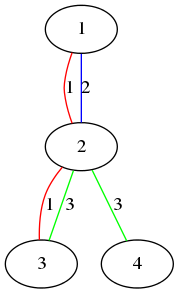Mr. Kitayuta has just bought an undirected graph consisting of n vertices and m edges. The vertices of the graph are numbered from 1 to n. Each edge, namely edge i, has a color ci, connecting vertex ai and bi.
Mr. Kitayuta wants you to process the following q queries.
In the i-th query, he gives you two integers — ui and vi.
Find the number of the colors that satisfy the following condition: the edges of that color connect vertex ui and vertex vi directly or indirectly.
The first line of the input contains space-separated two integers — n and m (2 ≤ n ≤ 100, 1 ≤ m ≤ 100), denoting the number of the vertices and the number of the edges, respectively.
The next m lines contain space-separated three integers — ai, bi (1 ≤ ai < bi ≤ n) and ci (1 ≤ ci ≤ m). Note that there can be multiple edges between two vertices. However, there are no multiple edges of the same color between two vertices, that is, if i ≠ j, (ai, bi, ci) ≠ (aj, bj, cj).
The next line contains a integer — q (1 ≤ q ≤ 100), denoting the number of the queries.
Then follows q lines, containing space-separated two integers — ui and vi (1 ≤ ui, vi ≤ n). It is guaranteed that ui ≠ vi.
For each query, print the answer in a separate line.
4 5
1 2 1
1 2 2
2 3 1
2 3 3
2 4 3
3
1 2
3 4
1 4
2
1
0
5 7
1 5 1
2 5 1
3 5 1
4 5 1
1 2 2
2 3 2
3 4 2
5
1 5
5 1
2 5
1 5
1 4
1
1
1
1
2
Let's consider the first sample.
 The figure above shows the first sample.
The figure above shows the first sample.- Vertex 1 and vertex 2 are connected by color 1 and 2.
- Vertex 3 and vertex 4 are connected by color 3.
- Vertex 1 and vertex 4 are not connected by any single color.
思路:
很不错的一道题目。
首先看他最后的那个问题“Find the number of the colors that satisfy the following condition: the edges of that color connect vertex ui and vertex vi directly or indirectly.”找出可以连通两点的个数,那个可以把这个问题退一步——相同颜色的点怎样才算是连通?
其实这就是一道更高维度的并查集,从而更好的揭示了并查集的实质:两个点的连通问题——他们连通的条件是什么?
这道题是对这一隐藏现象的揭示
#include <iostream> #include <cstring> #include <cstdio> #define maxn 207 using namespace std; int set[maxn][maxn]; int init() { for(int i = 1;i <= maxn;i++) for(int j = 1;j <= maxn;j++) set[i][j] = j; } int find(int color,int x) { int i; for(i = x;i != set[color][i];i = set[color][i]) set[color][i] = set[color][set[color][i]]; return i; } void set_together(int color,int t1,int t2) { int fx = find(color,t1); int fy = find(color,t2); if(fx != fy) set[color][fx] = fy; } int main() { int q; int n,m; int t1,t2,t; int ans; while(~scanf("%d%d",&n,&m)) { init(); for(int i = 1;i <= m;i++) { scanf("%d%d%d",&t1,&t2,&t); set_together(t,t1,t2); } scanf("%d",&q); while(q--) { ans = 0; scanf("%d%d",&t1,&t2); for(int i = 1;i <= m;i++) if(find(i,t1) == find(i,t2)) ans++; cout<<ans<<endl; } } return 0; }